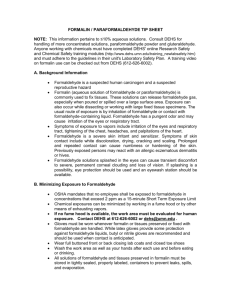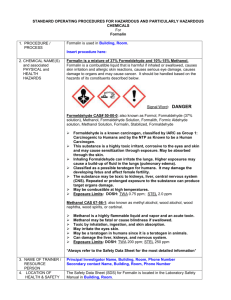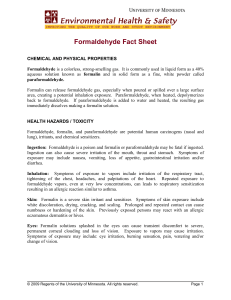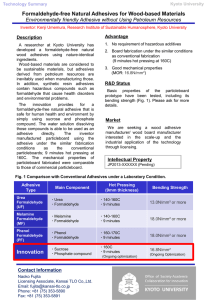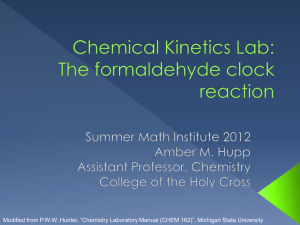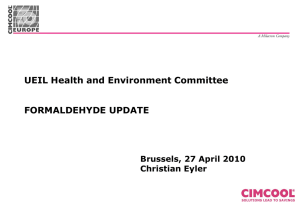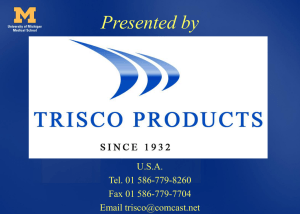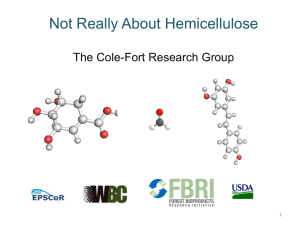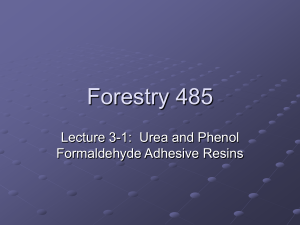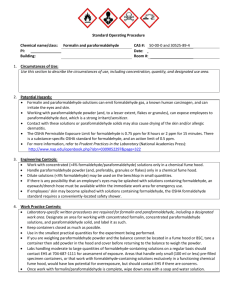DOSH Formaldehyde Standard WAC 296-856
advertisement
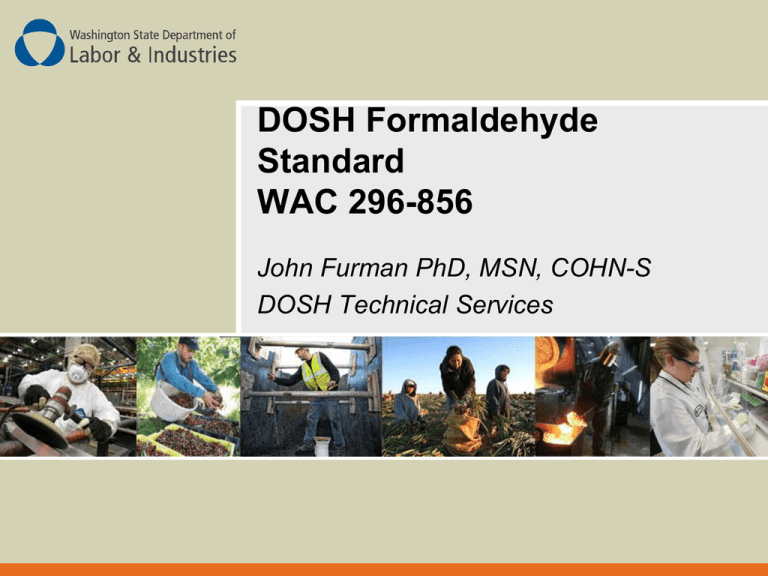
DOSH Formaldehyde Standard WAC 296-856 John Furman PhD, MSN, COHN-S DOSH Technical Services Scope Applies to all occupational exposures to formaldehyde (formaldehyde gas, its solutions and materials that release formaldehyde) – Formalin – 10-37% formaldehyde in solution with methanol or water Formaldehyde Formalin Formic Acid Paraformaldhyde Formal Methyl Aldhyde Methylene Glycol Exposure Vapors - Formaldehyde is a Volatile Organic Compound (VOC) that can be released as a vapor at room temperature. Liquids – Is a skin/mucous membrane irritant and sensitizer Common uses Tissue preservatives and in embalming fluids in autopsy rooms and pathology labs. Kidney dialysis units and central supply as a sterilant. In operating rooms as a tissue preservative, and disinfectant. Permissible Exposure Limits TWA – 0.75ppm, as an 8-hour time-weighted average STEL- 2.0ppm, any 15-minute period during the work shift Action Level (AL) – 0.5ppm, as an 8-hour TWA – Exposure monitoring – Medical surveillance Exposure Monitoring Initial Monitoring – All employees who may be exposed at or above the AL or STEL Periodic Monitoring – Exposures at or above the Action Level, repeat monitoring every 6 months Termination of Monitoring – If the result from two consecutive sampling periods taken at least 7 days apart indicate exposure below the Action Level and the STEL Exposure Monitoring Provide written notification of exposure monitoring results to employees within 5 days of receipt. Exposure monitoring is not necessary if you have documentation conclusively demonstrating that exposures will not exceed the AL or STEL. Labeling Label substances composed of greater than 0.1 percent formaldehyde and capable of releasing formaldehyde at concentrations greater than 0.1ppm to 0.5ppm. Label templates can be found on the DOSH Chemical Hazard Communication web page. Regulated Areas Shall be established where airborne formaldehyde concentrations exceed the TWA and STEL Post danger signs at entrances Access limited to authorized persons Engineering Controls Institute engineering controls and work practices to maintain exposures below the TWA and STEL – Local exhaust Ventilation (BSCs) – General ventilation Where necessary supplement engineering controls with respiratory protection Work Practices Keep solutions of formaldehyde closed when not in use Perform tasks involving formaldehyde in wellventilated areas Do not autoclave or microwave formaldehyde solutions Use substitute products whenever possible Respiratory Protection Where respirator use is required, a respiratory protection program conforming with WAC 296842 will be instituted. Use full-facepiece air-purifying respirators with cartridges or canisters approved for protection against formaldehyde. Protective Equipment Protect employees from contact with liquids containing 1 percent or more of formaldehyde. Employers must ensure that employees wear PPE and respiratory protection. Gloves Breakthrough times and permeation data are available from most manufactures Materials such as neoprene or nitrile are recommended Latex is not resistant to most chemicals, including formaldehyde Hygiene Change rooms - Provided for employees required to change into protective clothing. Emergency showers - Provided where employees may be splashed with solutions containing >10% formaldehyde Emergency eye washes - Provided where employees eyes may be splashed with solutions containing >0.1% formaldehyde. Housekeeping Preventative maintenance of equipment, including surveys for leaks will be performed regularly. Provisions for containing spills will be made. – WAC 296-824, Emergency Response applies whenever an uncontrolled release of formaldehyde may occur. Medical Surveillance For employees – Initially and every 12 months for employees exposed above the AL or STEL – Exposed during an emergency situation – Who develop signs and symptoms of exposure Performed by or directly supervised by a licensed physician. Medical Removal The employer’s LHCP may implement job restrictions or removal Pay, seniority and benefits are protected for 6 months Employees may seek a second medical opinion. Lab Standard WAC 296-828 Applies to laboratory use of hazardous chemicals A written Chemical Hygiene Plan is required WAC 296-856, applies to histology, pathology, and anatomy laboratories Information and Training Provide training to all exposed employees Every 12 months and whenever a new hazard is introduced Training content is listed in the Standard Make MSDS available Recordkeeping Maintain records of: – All measurements taken to monitor employee exposure. – Data used to determine that exposures will not exceed the PELs – Medical surveillance information. – Respirator fit testing. Recent Citations WAC 296-824 – Emergency Response – Stores over 25 gallons of 10% formalin in 5, five gallon cubes. – Employees were not trained on hazards and spill clean up procedures – $700.00 penalty Citations WAC 296-856-200 – Training – Employees pour formalin or use prefilled formalin containers for specimens obtained from surgery. Employees working in an area where a formalin spill could occur were not trained on the hazards of formalin exposure. – $2,100.00 penalty Citations WAC 296-828 – Lab Standard – The employer did not inform and train laboratory employees about the presence of hazardous chemicals – Pathology lab employees exposed to 10% formalin were not trained on the S/S of exposure, Appropriate work practices, emergency procedures, personal protective equipment – $300.00 penalty Citations WAC 296-856-200 – PPE – The employer did not ensure eye protection and face shields were worn for protection from exposure to formaldehyde vapor and splash. – You must also ensure that when face shields are worn, employees also wear chemical safety goggles – $700.00 penalty Citations WAC 296-800-150 – Emergency Washing – The employer did not ensure that an emergency eye wash was available where an employee's eyes could come into contact with corrosives, strong irritants, or toxic chemicals. – Exposure to formalin and metricide – $1,200 penalty Information For more information contact Pam Edwards, IH4, 360-902-5436 or EDWP@lni.wa.gov For on-site help with exposure monitoring, PPE selection, etc. contact your local DOSH Consultation office.
